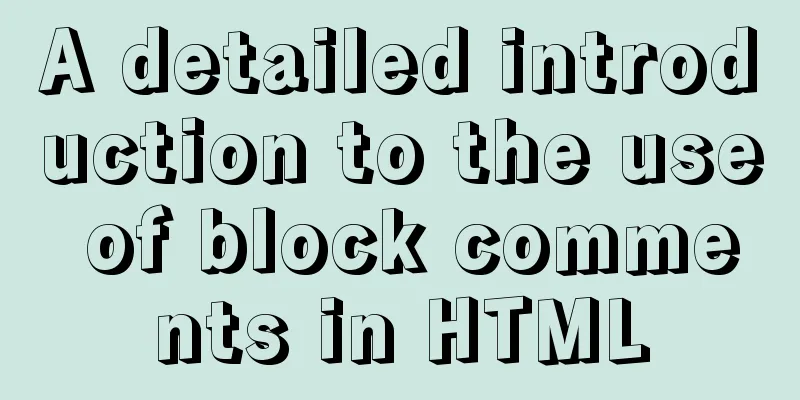A detailed introduction to the use of block comments in HTML

|
Common comments in HTML: <!--XXXXXXXX-->, where XXXXXXXX is the comment content Block comment css in html <!--[if IE]>….<![endif]--> (<!--[if !IE]>||<![endif] Copy code The code is as follows:1. <!--[if !IE]><!--> Recognizable except IE<!--<![endif]--> 2. <!--[if IE]> All IE can recognize<![endif]--> 3. <!--[if IE 5.0]> Only IE5.0 can recognize<![endif]--> 4. <!--[if IE 5]> Only IE5.0 and IE5.5 can recognize<![endif]--> 5. <!--[if gt IE 5.0]> IE5.0 and above can recognize<![endif]--> 6. <!--[if IE 6]> Only IE6 can recognize<![endif]--> 7. <!--[if lt IE 6]> IE6 and below versions can recognize<![endif]--> 8. <!--[if gte IE 6]> IE6 and above versions can recognize<![endif]--> 9. <!--[if IE 7]> Only IE7 can recognize<![endif]--> 10. <!--[if lt IE 7]> IE7 and below versions can recognize<![endif]--> 11. <!--[if gte IE 7]> IE7 and above versions can recognize<![endif]--> <!--[if lte IE 6]>……<![endif]--> Ite: less than or equal to means less than or equal to IE6 browser, used for conditional comments of IE browser, often used in CSShack, JS for IE, etc. In the process of learning and applying WEB standard web pages, the compatibility of web pages with browsers is a problem that we often encounter. Among them, Microsoft's Internet Explorer (IE for short) occupies most of the browser market, and there are also Firefox, Opera, etc. Compatibility with these browsers is required. At the same time, as far as IE is concerned, due to the upgrade and replacement of IE versions, the current browsers mainly use the three versions of IE5 (IE5.5), IE6 and IE7. However, these three versions have different interpretations and executions of the WEB standard web pages (XHTML+CSS) we create. Also, other non-IE browsers interpret some CSS differently from IE. Therefore, the dedicated conditional comments in the IE browser can be used to define relevant attributes in a targeted manner. Conditional comments can only be used in Explorer 5+ Windows (hereinafter referred to as IE) (conditional comments are supported starting from IE5). If you have multiple IE versions installed, conditional comments will be based on the highest version of IE (currently IE 7). Conditional comments can only be used in Windows Internet Explorer (hereinafter referred to as IE), so we can use conditional comments to add special instructions for IE. In simple terms, conditional comments are some if judgments, but these judgments are not executed in the script, but directly in the HTML code, for example: <!--[if IE]> Here is the normal html code <![endif]--> 1. The basic structure of conditional comments is the same as HTML comments (<!-- -->). Therefore browsers other than IE will treat them as normal comments and completely ignore them. 2. IE will determine whether to parse the content in the conditional comment like parsing normal page content based on the if condition. 3. Conditional comments use the HTML comment structure, so they can only be used in HTML files, not in CSS files. You can use the following code to detect the current IE browser version (note: the effect will not be seen in non-IE browsers) Copy code The code is as follows:<!--[if IE]> <h1>You are using IE browser</h1> <!--[if IE 5]> <h2>Version 5</h2> <![endif]--> <!--[if IE 5.0]> <h2>Version 5.0</h2> <![endif]--> <!--[if IE 5.5]> <h2>Version 5.5</h2> <![endif]--> <!--[if IE 6]> <h2>Version 6</h2> <![endif]--> <!--[if IE 7]> <h2>Version 7</h2> <![endif]--> <![endif]--> What if the current browser is IE, but the version is lower than IE5? You can use <!--[if ls IE 5]>. Of course, conditional comments can only be used in the IE5+ environment, so <!--[if ls IE 5]> will not be executed at all. lte: is the abbreviation of Less than or equal to, which means less than or equal to. lt: It is the abbreviation of Less than, which means less than. gte: is the abbreviation of Greater than or equal to, which means greater than or equal to. gt: It is the abbreviation of Greater than, which means greater than. ! : It means not equal, which is the same as the not equal to judgement operator in JavaScript Are conditional comments a CSS hack? Are conditional comments a CSS hack? Strictly speaking, it is a CSS hack. Because just like any other real CSS hack, it allows us to give special styles to some browsers, and it does not rely on a browser bug to control another browser (style). In addition, conditionals can also be used to do things beyond the scope of CSS HACK (although this rarely happens). Because conditional judgment does not rely on a browser hack, but is a well-thought-out feature, I believe it can be used with confidence. Of course, other browsers may also support conditionals (so far they don't), but it seems unlikely that they will use syntax like <!--[if IE]>. How to apply conditional comments <br />This article explains at the beginning that because different versions of IE browsers interpret the WEB standard pages we make differently, specifically the interpretation of CSS is different. In order to be compatible with them, we can use conditional comments to define them separately and ultimately achieve the purpose of compatibility. for example: Copy code The code is as follows:<!-- By default, the css.css style sheet is called first--> <link rel="stylesheet" type="text/css" href="css.css" /> <!--[if IE 7]> <!-- If the IE browser version is 7, call the ie7.css style sheet --> <link rel="stylesheet" type="text/css" href="ie7.css" /> <![endif]--> <!--[if lte IE 6]> <!-- If the IE browser version is less than or equal to 6, call the ie.css style sheet --> <link rel="stylesheet" type="text/css" href="ie.css" /> <![endif]--> This distinguishes the execution of CSS in browsers lower than IE7 and IE6 to achieve compatibility. At the same time, the default css.css in the first line can also be compatible with other non-IE browsers. Note: The default CSS style should be located in the first line of the HTML document, and all content for conditional comment judgment must be located after the default style. For example, the following code is displayed in red when executed in IE browser, but in black when executed in non-IE browsers. If the conditional comment judgment is placed in the first line, it cannot be implemented. This example can well illustrate how to solve the compatibility problem between IE browser and non-IE browser. Copy code The code is as follows:<style type="text/css"> body{ background-color: #000; } </style> <!--[if IE]> <style type="text/css"> body{ background-color: #F00; } </style> <![endif]--> At the same time, some people may try to use <!--[if !IE]> to define the situation under non-IE browsers, but please note: conditional comments can only be executed under IE browsers. This code will not only not execute the definition under the condition under non-IE browsers, but will be ignored as a comment. Normal is the default style, and conditional comments are performed only when special processing is required for IE browsers. In HTML files, not in CSS files. |
<<: How to build SFTP server and image server on Linux cloud server
>>: border-radius method to add rounded borders to elements
Recommend
Cross-domain issues in front-end and back-end separation of Vue+SpringBoot
In the front-end and back-end separation developm...
Detailed explanation of Nginx Rewrite usage scenarios and code examples
Nginx Rewrite usage scenarios 1. URL address jump...
How to choose the right MySQL datetime type to store your time
When building a database and writing a program, i...
js to achieve cool fireworks effect
This article shares the specific code for using j...
mysql-8.0.15-winx64 decompression version installation tutorial and three ways to exit
1. Download from the official website and unzip h...
Solution to mysql failure to start due to insufficient disk space in ubuntu
Preface Recently, I added two fields to a table i...
Windows platform configuration 5.7 version + MySQL database service
Includes the process of initializing the root use...
Detailed explanation of the code between the MySQL master library binlog (master-log) and the slave library relay-log
Main library binlog: # at 2420 #170809 17:16:20 s...
Detailed explanation of the frame and rules attributes of the table in HTML
The frame and rules attributes of the table tag c...
SQL Get stored procedure return data process analysis
This article mainly introduces the analysis of th...
Interview questions: The difference between the Holy Grail layout and the double-wing layout
Preface Today I will share with you a holy grail ...
How to quickly import data into MySQL
Preface: In daily study and work, we often encoun...
Next.js Getting Started Tutorial
Table of contents Introduction Create a Next.js p...
MySQL 5.7.19 installation tutorial under Windows 10 How to change the root password of MySQL after forgetting it
Take MySQL 5.7.19 installation as an example, fir...
Vue template configuration and webstorm code format specification settings
Table of contents 1. Compiler code format specifi...









